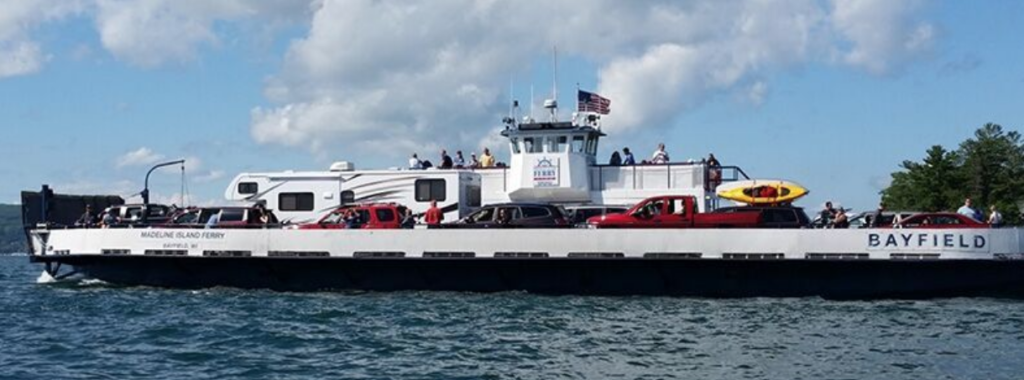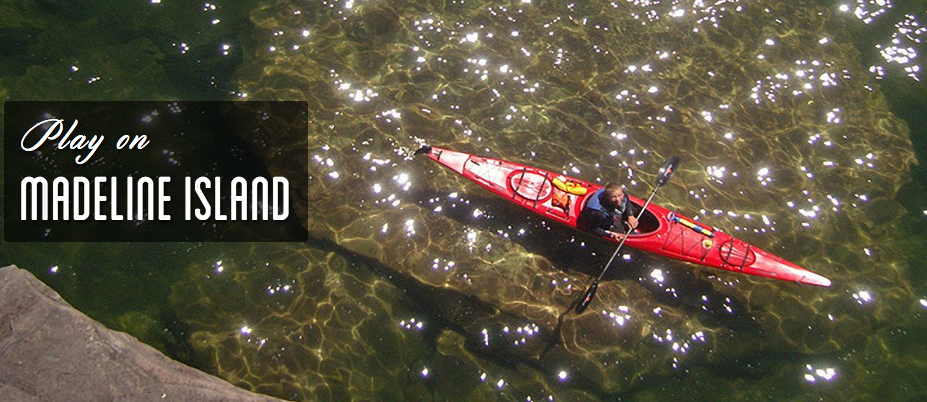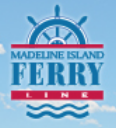
Today’s Ferry
The year 1995 marked the 25th Anniversary of the Madeline Island Ferry Line: a quarter of a century since the merger of two rival ferry lines operating on the Bayfield to La Pointe route formed a single carrier. Today’s ferry line continues the long legacy of commercial transportation over water routes on Chequamegon Bay on Lake Superior’s south shore.
The first crossing of the 1995 season took place on March 23rd. The steel car ferries Island Queen and Nichevo II made the trip: the Island Queen starting from Bayfield, and the Nichevo II from La Pointe. Cutting through up to 18 inches of ice with some difficulty, the ferries met and passed each other while crowds yelled and waved. Both boats once worked on the earlier, competing lines.
The Madeline Island Ferry Line retains strong ties to its heritage. Among corporate owners are members of both the Russell and Nelson families associated with the earlier island ferry lines.
But today’s ferry boat transportation has changed immensely from the services that operated here 150 years earlier. Sail and hand-powered wooden boats have been replaced by steel, diesel-engine vessels. And today’s ferries are designed to carry automobiles — a type of vehicle never dreamed of when the communities of Ashland, Washburn and Bayfield were rustic settlements on the Lake Superior frontier. Modern ferry boats operate nearly exclusively for transporting people and freight between terminals on a set route. But during the boom in tourism at the turn-of-the-century, Chequamegon Bay ferry boats did dual work as excursion boats among the adjacent Apostle Islands.
Though freight, as well as passengers, has always been carried by local ferries, large loads used to be towed behind on barges. But today, the 90-foot, drive-through ferry Madeline and the 110-foot double ended Bayfield are capable of loading many large shipments. These include fuel trucks, construction equipment, and even an occasional house.
Employees of the Madeline Island Ferry Line are skilled in a task unheard of by ferry boat captains of a century ago: they can size up a line of waiting vehicles and load them aboard a boat according to size and weight, in the most efficient manner possible. But with nearly 6,000 crossings made annually, they have had a lot of practice.
An industry long-dominated by men, Madeline Island Ferry Line has taken a new turn. Women of the past, participated in this work by managing home and family, enabling captains to put in long days on the lake. Today women work in many aspects of the business: from ticket sales, to deck handing, and to piloting the vessels. There are four Coast Guard Licensed female captains who run the ferries between Bayfield and La Pointe, often there will be an all female crew.
The many passengers that have stepped aboard area ferry boats over the decades, have placed their trust in the skill and knowledge of vessel captains to take them safely to the other shore. And they have not been let down. A century-and-a-half of ferry boat crossings have a virtually disaster-free history. Though Lake Superior can change within minutes from a placid pond to a raging sea, area mariners knowingly read the skies and safely maneuver their boats between ports. Today’s ferries carry regulation Coast Guard safety equipment, radar and marine radios. Crews are trained in man-overboard and disaster procedures.
Once a common form of transportation for residents in all Chequamegon Bay communities, taking a ferry ride is an unusual experience for most people in the late 20th-century. But not so for the year-round and summer residents of Madeline Island. Here, the ferry is part of the local culture. These individuals plan their activities by the ferry schedule, and it even affects their conversation. Upon arriving at La Pointe for the summer season, it is common to hear a person report that they “arrived last night on the 8 o’clock boat.”
The Madeline Island Ferry Line management respects its significance in area history and its location in the unique Apostle Islands region. The corporation’s Mission Statement includes the aim to “provide positive cultural, environmental and economic impact to the Island and Bayfield communities,” in addition to providing quality transportation to meet the present and future needs of residents and visitors.
Though the great steamers and festive pleasure yachts that graced the bay in an earlier century have been replaced with fiberglass sailing craft and trolling boats, ferry boats still ply the waters. In an endless journey they cross and re-cross the bay, just as they have done for nearly 150 years. They are part of the unique cultural heritage of the Chequamegon Bay region.

For more information about Ferry Line Schedule and Rates please log on to http://madelineisland.chambermaster.com/list/member/madeline-island-ferry-line-52








